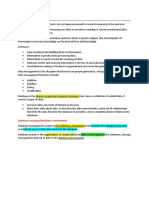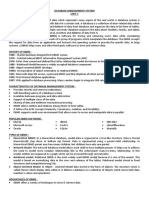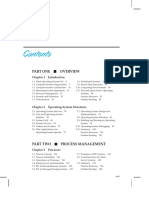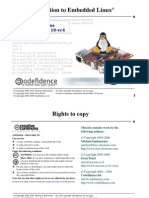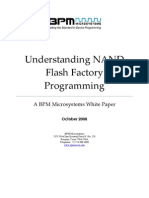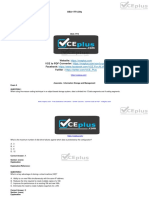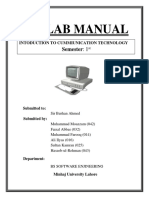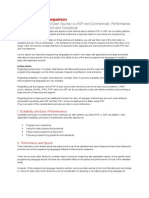0 ratings0% found this document useful (0 votes)
11 views10 pagesChapter 1 Database Systems
In this chapter, you will learn:
• The difference between data and information
• What a database is, the various types of databases, and why they are valuable assets for
decision making
• The importance of database design
• How modern databases evolved from file systems
• About flaws in file system data management
• The main components of the database system
• The main functions of a database management system (DBMS)
Uploaded by
Stephanie FoleyCopyright
© © All Rights Reserved
We take content rights seriously. If you suspect this is your content, claim it here.
Available Formats
Download as DOCX, PDF, TXT or read online on Scribd
0 ratings0% found this document useful (0 votes)
11 views10 pagesChapter 1 Database Systems
In this chapter, you will learn:
• The difference between data and information
• What a database is, the various types of databases, and why they are valuable assets for
decision making
• The importance of database design
• How modern databases evolved from file systems
• About flaws in file system data management
• The main components of the database system
• The main functions of a database management system (DBMS)
Uploaded by
Stephanie FoleyCopyright
© © All Rights Reserved
We take content rights seriously. If you suspect this is your content, claim it here.
Available Formats
Download as DOCX, PDF, TXT or read online on Scribd
You are on page 1/ 10
Database Systems
Data vs. Info
o Data
Data-raw facts, or facts that have not yet been processed to reveal their meaning to the end user
Data consists of raw facts
Raw indicates that facts haven’t yet been processed to reveal their meaning
Data processing can be as simple as organizing data to reveal patterns or as complex as making forecasts or drawing
inferences using statistical modeling
Raw data must be properly formatted for storage, processing, & presentation
Must be properly generated & stored in a format that is easy to access & process
Data Management-is a discipline that focuses on proper generation, storage, & retrieval of data
o Information
Information-the result of processing raw data to reveal its meaning; consists of transformed data & facilitates decision
making
Information is result of processing raw data to reveal its meaning
Production of accurate, relevant, & timely information is key to good decision making
Data r foundation of info
Knowledge-is body of information & facts about a specific subject
Implies familiarity, awareness, & understanding of info as it applies to an environment
Key characteristics of it is that “new” knowledge can be derived from “old” knowledge
o Knowledge-the body of information & facts about a specific subject; implies familiarity, awareness, & understanding of
information as it applies to an eviron.; a key characteristic is that new knowledge can be derived fr old knowledge
o Data Management-a process that focuses on data collection, storage, & retrieval; common data management functions
includes addition, deletion, modification, & listing
Into to Database
o Database is a shared, integrated computer structure that stores a collection of end-user data & metadata
o Database-a shared, integrated computer structure that houses a collection of related data
End-user data is raw facts of interest to end user
Metadata
Metadata-, or data about data, thru which end-user data r integrated & managed
Metadata-data about data; that is, data about data characteristics & relationships
describe data characteristics & set of relationships that links the data found within database
provide info that complements & expands value & use of data
present a more complete picture of the data in database
o Database Management Systems (DBMS) is a collection of programs that manages database structure & controls
access to data stored in database
o Role & Advantages of DBMS
Roles
DBMS serves as intermediary between user & database
Database structure itself is stored as a collection of files, & only way to access data in those files is thru DBMS
Present end user (or app program) w/ a single, integrated view of data
receives all app requests & translates them into complex operations required to fulfill those requests
hides much of database’s internal complexity fr app programs & users
Advantages
enables data in database to be shared among multiple apps or users
integrates many different users’ views of data into a single-encompassing data repository
Other Advantages:
1. Improved data sharing
Helps create an environ. in which end users have better access to more & better managed data
Such access make it possible for end users to respond quickly to changes in their environ.
2. Improved data security
More users access data, greater the risks of data security breaches
DBMS provides a framework for better enforcement of data privacy & security policies
3. Better data integration
Wider access to well-managed data promotes an integrated view of organization’s operations & a clearer view of
big picture
It becomes much easier to see how in one segment of the company affect other segments
4. Minimized data inconsistency
Data Inconsistency exists when different versions of same data appear in different places
Data Inconsistency-a condition in which different versions of the same data appear in different (inconsistent)
results
Probability of data inconsistency is greatly reduced in a properly design database
5. Improved data access
DBMS makes it possible to produce quick answers to ad hoc queries
Query is a specific request issues to DBMS for data manipulation
Query-a question or task asked by an end user of a database in the form of SQL code; a specific request for data
manipulation issued by the end user or the application to the DBMS
Ad Hoc Query-is a spur-of-the-moment question
Query Result Set is an answer that is sent back by DBMS
Query Result Set-is the collection of data rows returned by a query
6. Improved decision making
Better-managed data & improved data access make it possible to generate better-quality information, on which
better decisions r based
Quality of info generated depends on quality of underlying data
Data Quality is a comprehensive approach to promoting the accuracy, validity, & timelines of data
Data Quality-a comprehensive approach to ensuring the accuracy, validity, & timeliness of data
it provides a framework to facilitate data quality initiatives while DBMS doesn’t guarantee data quality
7. Increased end-user productivity
Availability of data, combined w/ tools that transform data into usable info, empowers end users to make quick,
informed decisions that can make difference between success & failure in global economy
o Types of Databases
DBMS can be used to build many different types of databases
Each one stores a particular collection of data & is used for a specific purpose
# of users determines whether database is classified as single user or multiuser
Single-User Database
Single-User Database supports only one user at a time
Single-User Database-a database that supports only one user at a time
If user A is using the database, user B & C must wait until user A is done
A single-user database that runs on a personal computer is called a desktop database
Multiuser Database
Multiuser Database supports multiple users at the same time
Multiuser Database-a database that supports multiple concurrent users
Workgroup Database-a type of multiuser database that usually supports fewer than 50 or used for a specific
department within an organization
Enterprise Database-the overall company data representation, which provides support for present & expected future
needs
Location might also be used to classify database
Centralized Database is a database that supports data located at a single site
Centralized Database-a database located at a single site
A database that supports data distributed across several different sites is called a distributed database
Distributed Database-a logically related database that is stored in two or more physically independent sites
Both centralized & decentralized (distributed) databases require well-defined infrastructure (hardware, os (operating
systems, network technologies, etc) to implement & operate database
Infrastructure is owned & maintained by organization that creates & operates database
Cloud Database
Cloud Database-a database that is created & maintained using cloud data services, such as Microsoft Azure or
Amazon’s AWS)
Provide defined performance measures (data storage capacity, required thruput, & availability) for database, but
don’t necessarily specify underlying infrastructure to implement it
Data owner doesn’t have to know, or be concerned about, what hardware & software is being used to support their
database
Performance capabilities can be renegotiated w/ cloud provider as business demands on database changes
A popular way of classifying databases is according to type of data stored in them
Using this criterion, database r grouped into two categories
General-Purpose Databases
General-Purpose Databases contain a wide variety of data used in multiple disciplines
General-Purpose Database-a database that contains a wide variety of data used in multiple disciplines
Discipline-Specific Databases
Discipline-Specific Databases contain data focused on specific subject areas
Discipline-Specific Database-a database that contains data focused on specific subject areas
Data in this r used mainly for academic or research purposes within a small set of disciplines
Most popular way of classifying databases today is based on how they will be used & on sensitivity of info gathered fr
them
A database that is designed primarily to support a company’s day-to-day operations is classified as an operational
database, also known as an online transaction processing (OLTP) database, transactional database or
production database
Operational Database-a database designed primarily to support a company’s day-to-day operations; also known as
transactional database, OLTP database, or production database
Analytical Database
Analytical Database focuses primarily on storing historical data & business metrics used exclusively for tactical or
strategic decision making
Analytical Database-a database focused primarily on sorting historical data & business metrics used for tactical or
strategic decision making
Such analysis requires extensive “data massaging”) data manipulation to produce info for businesses
Allow end user to perform advanced data analysis of business data using sophisticated tools
Comprise of two main components:
Data Warehouse
Data Warehouse-a specialized database that stores historical & aggregated data in format optimized for decision
support
is a specialized database that stores data in a format optimized for decision support
Contains historical data obtained from operational databases as well as data fr other external sources
Online Analytical Processing (OLAP)-a set of tools that work together to provide an advanced data analysis environ.
for retrieving, processing, & modeling data fr data warehouse
Business Intelligence describes a comprehensive approach to capture & process business data w/ purpose of
generating info to support business decision making
Business Intelligence-a set of tools & processes used to capture, collect, integrate, store, & analyze data to support
business decision making
can also be classified to reflect degree to which data r structured
Unstructured Data r data that exist in their original (raw) state-that is, in format in which they were collected
Unstructured Data-data that exists in its original, raw state; that is, in the format in which it was collected
Exist in a format that doesn’t lend itself to processing that yields info
Structured Data r result of formatting unstructured data to facilitate storage, & generation of info
Structured Data-data that has been formatted to facilitate storage, use, & information generation
Apply structure (format) based on type of processing that u intend to perform on data
Most data u encounter r best classified as semistructured
Semistructured Data have already been processed to some extent
Semistructured Data-data that has already been processed to some extent
Ones mentioned so far focus on storage & management of highly structured data
Corporations r not limited to use of structured data, but they also use semistructured & unstructured data
unstructured & semistructured data storage & management needs r being addressed thru a new generation of
databases known as XML databases
Extensible Markup Language (XML) is a special language used to represent & manipulate data elements in a textual
format
Extensible Markup Language (XML)-a metalanguage used to represent & manipulate data elements; unlike other
markup langs, XML permits the manipulation of a document’s data elements
XML Database supports storage & management of semistructured XML data
XML Database-a database system that stores & manages semistructured XML data
Types of Databases
Number of Users Data Location Data Usage
Multiuser
Product Single Centraliz Distribut Operatio Analytic XML
Workgrou Enterpri
User ed ed nal al
p se
MS Access X X X X
MS SQL
X3 X X X X X X X
Server
IBM DB2 X3 X X X X X X X
MySQL X X X X X X X X
Oracle RDBMS X3
X X X X X X X
Social Media-refers to web & mobile technologies that enable “anywhere, anytime, always on” human interactions
(greats amount of data being stored & analyzed)
These data grow exponentially & require use of specialized database systems
Social media user a new type of database is known as a NoSQL database
NoSQL (Not only SQL) is generally used to describe a new generation of database management systems that is not
based on traditional relational database model
NoSQL-a new generation of database management systems that isn’t based on the traditional relational database
model
This database r designed to handle unprecedented volume of data, variety of data types & structures, & velocity of
data operations that r characteristic of these new business requirements
o Why Database Design is Important?
Database Design refers to activities that focus on design of database structure that will be used to stored & manage
end-user data
Database Design-the process that yields the description of the database structure & determines the database
components; the second phase of the Database Life Cycle
Database design is crucial aspect of working w/ databases
Data r one of an organization’s most valuable assets
Data r all vital to existence of a company
Thorough planning to ensure that data r properly used & leveraged to give company most benefit is just as important
as proper financial planning to ensure that company gets best use fr its financial resources
Proper design requires designer to identify precisely database’s expected to use
Designing a transactional database emphasizes accurate & consistent data & operational speed
Designing a data warehouse database emphasizes use of historical & aggregated data
Designing a database to be used in a centralized, single-user environ. requires a different approach fr that used in
design of a distributed, multiuser database
Designing appropriate data repositories of integrated info using 2D table structures found in most databases is a
process of decomposition
Integrated data must be decomposed properly into its constituent parts, & implemented so integrated view of data
can be re-created later as info for end user
Well-designed database facilitates data management & generates accurate & valuable info
Poorly designed database is likely to become a breeding ground for difficult-to-trace errors that may lead to bad
decision making-& bad decision making can lead to failure of an organization
Evolution of File System Data Processing
o Can be helpful in understanding data access limitations that databases attempt to overcome
o Understanding these limitations is relevant to database designers & developers b/c database technologies don’t make
these probs magically disappear-database technologies simply make it easier to create solutions that avoid these
probs
o Creating database designs that avoid pitfalls of earlier systems requires that designer understand these probs & how
to avoid them
o Manual File Systems
Organization must develop systems for handling core business tasks to be successful
Such system were often manual, paper and pencil system
Paper within these systems were organized to facilitate expected use of data
This was accomplished thru a system of file folders & filing cabinets
Served its role well as a data repository as long as collection of data was relatively small & an organization’s business
users had few reporting requirements
Keeping track of data in a manual file system become more difficult as organizations grew & as reporting
requirements became more complex
Therefore, companies looks to computer technology for help
o Computerized File Systems
Data Processing (DP) Specialist-create a computer-based system that would track data & produce required reports
Initially, computer files within file system were similar to manual files
Description of computer files requires a specialized vocabulary
Every discipline develops its own terminology to enable its practitioners to comm. clearly
o Basic File Terminology
Term Definition
Data Raw facts, such as telephone number, a birth date, a customer name, and a year-to-date (YTD) sales
value. Data have little meaning unless they have been organized in some logical manner.
Field A character or group of characters (alphabetic or numeric) that has a specific meaning. A field is used
to define & store data.
Record A logically connected set of one or more fields that describes a person, place, or thing. For example,
the fields that constitute a record for a customer might consist of the customer’s name, address,
phone number, date of birth, credit limit, & unpaid balance.
File A collection of related records. For example, a file might contain data about the students currently
enrolled at Gigantic University.
Business users sent requests for data to DP specialist when they want data fr computerized file
DP specialist had to create programs for each request to retrieve data from the file, manipulate it in whatever manner
user had requested, & present it as a printed report
DP specialist could rerun existing program & provide printed results to user if a request was for a report that had
been run previously
Probs w/ this type of file system became apparent as more & more computerized files were developed
Advent of computer files represent a huge step forward in a business’s ability to process data & to store company
data
Creation of it gave users improved tools for manipulating company data that allowed them to create new info
It had additional effect of introducing a schism between end users and their data
Desire to close gap between end users & data influenced development of many types of computer technologies,
system designs, & used (& misuses) of many technologies & techniques
Such developments also created a split between ways DP specialists & end users viewed the data
Fr DP specialist’s perspective, computer files within file system were created to be similar to manual files. Data
management programs were created to add to, update, & delete data fr the file.
Fr end user’s perspective, systems separated users fr data. As user’s competitive environ. pushed them to make
more & more decisions in less time, users became frustrated by delay between conceiving of a new way to create
info fr data & point when the DP specialist actually created programs to generate that information.
o File System Redux
Users’ desire for direct, hands-on access to data helped to fuel adoption of personal computers for business use
Personal computer spreadsheet programs such as Microsoft Excel r widely used by business users, & they allow user
to enter data in a series of rows & columns so data can be manipulated using a wide range of functions
Spreadsheet apps has enabled users to conduct sophisticated data analysis that has greatly enhanced their ability to
understand data & make better decisions
Common misuse of spreadsheets is as substitute for a database
End users often take limited to which they have direct access & place it in a spreadsheet format similar to that of
traditional, manual data storage systems0which is precisely what early DP specialists did when creating
computerized data files
o Probs w/ File System Data Processing
File system method of organizing & managing data was a definite improvement over manual system, & file system
served a useful purpose in data management
Critique of file system method serves two major purposes:
Purpose 1:
Understanding shortcomings of file system enables u to understand development of modern database
Purpose 2:
Many of probs aren’t unique to file systems
Failure to understand such probs is likely to lead to their duplication in a database environ., even though database
tech makes it easy to avoid them
Following probs associated w/ file systems, whether created by DP specialists or thru a series of spreadsheets,
severely challenge the types of info that can be created fr data as well as accuracy of info:
Lengthy development times
First & most glaring prob w/ file system approach is that even simplest data-retrieval task requires extensive
programming
w/ older file systems, programmers had to specify what must be done & how to do it
modern database use a nonprocedural data manipulation language that allows user to specify what must be done
w/o specifying how
Difficulty of getting quick answers
Need to write programs to produce even simplest reports makes ad hoc queries impossible
Harried DP specialists who worked w/ mature file systems often received numerous requests for new reports
They were often forced to say that report will be ready “next week” or even “next month”
Getting it next week or next month will not serve your info needs if u need info now
Complex system administration
System admin. Becomes more difficult as # of files in system expands
Even a simple file system w/ a few files requires creating & maintaining several file management programs
Each file must have its own file management programs that allow user to add, modify, & delete records; to list file
contents; & to generate reports
File reporting programs can multiply quickly b/c ad hoc queries aren’t possible
Prob is compounded by fact that each department in organization “owns” its data by creating its own files
Lack of security & limited data sharing
Another fault of a file system data repository is a lack of security & limited data sharing
Data sharing & security r closely related
Sharing data among multiple geographically dispersed users introduces a lot of security risks
In terms of spreadsheet data, while many spreadsheet programs provide rudimentary security options, they aren’t
always used, & even when they r, they r insufficient for robust data sharing among users
In terms of creating data management & reporting programs, security & data-sharing features r difficult to program
& consequently r often omitted fr a file system environ
Such features include effective password protection, ability to lock out parts of files or parts of system itself, &
other measures designed to safeguard data confidentiality
Even when an attempt is made to improve system & data security, security devices tend to be limited in scope &
effectiveness
Extensive programming
Making changes to an existing file structure can be difficult in a file system environ.
In fact, any change to a file structure, no matter how minor, forces modifications in all of programs that use data in
that file
Modifications r likely to produce errors (bugs), & additional time is spent using a debugging process to find thos errors
Those limitations, in turn, leads to probs of structural & data dependence
o Structural & Data Dependence
File system exhibits structural dependence
Structural Dependence-means that access to a file is dependent on its structure
All of file system programs must be modified to conform to new file structure
Exhibit structural dependence b/c file system app. programs r affected by changes in file structure
Structural Independence-exists when u can change file structure w/o affecting app.’s ability to access data
Even changes in characteristics change (that is, changing data type), file system is said to exhibit data dependence
Data independence exists when u can change data storage characteristics w/o affecting program’s ability to access
ability
practical significance of data dependence is the difference between logical data format (how human being views
data) & physical data format (how computer must work w/ data)
any program that accesses a file system’s file must tell computer not only what to do but how to do it
each program must contain lines that specify opening of a specific file type, its record specification, & its field
definitions
database dependence makes file system extremely cumbersome fr point of view of a programmer & database
manager
o Data Redundancy
Organizational structure promotes storage of same basic data in different locations
Database pros use term islands of info for such scattered data locations
Dispersion of data is exacerbated by use of spreadsheets to store data
Islands of info often contain different versions of same data b/c data stored in different locations will probably not be
updated consistently
Data Redundancy-exists when same data r stored unnecessarily at different places
Uncontrolled data redundancy sets stage for following:
Poor data security
Having multiple copies of data increases chances for a copy of data to be susceptible to unauthorized access
Data inconsistency
Exists when different & conflicting versions of same data appear in different places
Reports will yield inconsistent results that depend on which version of data is used
Note
Date display data inconsistency r also referred to as data
that lack data integrity.
Data Integrity-is defined as the condition in which all of
data in the database r consistent w/ real-world events &
conditions
Data integrity means that:
o Data r accurate-there r no data inconsistencies
o Data r verifiable-the data will always yield consistent
Data-entry errors r more likely to occur when complex entries r made in several different files or recur frequently in
one or more files
Data anomalies
A field value change should be made in only a single space
Data redundancy, however, fosters an abnormal condition by forcing field value changes in many different
locations
Any change in any field value must be correctly made in many places to maintain data integrity
Data Anomaly-develops when not all of the required changes in the redundant data r made successfully
Data anomalies r commonly defined as follows:
Update anomalies
Insertion anomalies
Deletion anomalies
o Lack of Design & Data-Modeling Skills
New prob that has evolved w/ use of personal productivity tools (such as spreadsheets & desktop databases) is that
users typically lack proper design & data-modeling skills
People naturally have an integrated view of data in their environ.
Forcing this type of integrated data into a single 2D table structure is a poor data design that leads to a large degree
of redundancy for several data items
Data-modeling skills r also vital part of design process
It is important to documents design properly
Design documentation is necessary to facilitate communication among database designer, end user, & developer
Data modeling is most common method of documenting database designs
Using a standardized data-modeling technique ensures that data model fulfills its role in facilitating comm.
Data model also provides an invaluable resource when maintaining or modifying a database as business
requirements change
Database Systems
o Consists of logically related data stored in a single logical data repository unlike file system w/ its many separate &
unrelated files
o “logical” label reflects fact that data repository appears to be a single unit to end user, even though data might be
physically distributed among multiple storage facilities & locations
o Database represents a major change in way end-user data r stored, accessed, & managed b/c database’s data
repository is a single logical unit
o Database’s DBMS provides numerous advantages over file system management by making it possible to eliminate
most of fiel system’s data inconsistency, data anomaly, data dependence, & structural dependence probs
o Current generation of DBMS software stores not only data structures, but also relationships between those structures &
access paths to those structures-all in a central location
o Current generation of DBMS software also takes care of defining, storing, & managing all required access paths to
those components
o Database & File Systems Contrasting Example:
o Database System Environment
Database System-refers to an organization of components that define & regulate the collection, storage,
management, & use of data within a database environment
Is composed of five major parts:
Hardware
Refers to all of system’s physical devices, including computers (PCs, workstations, servers, & supercomputers),
storage devices, printers, network devices (hubs, switches, routers, fiber optics), & other devices (automated teller
machines, ID readers, & so on)
Software
Three types of it r needed to make database systems system functionally:
OS (operating systems) software
Manages all hardware components & makes it possible for all other software to run on computers
DBMS software
Manages database within database system
App programs & utilities
R used to access & manipulate data in DBMS & to manage computer environ. in which data access &
manipulation take place
App programs r most commonly used to access data within database to generate reports, tabulations, & other
info to facilitate decision making
Utilities r software tools used to help manage database system’s computer components
All major DBMS vendors provide graphical user interfaces (GUIs) to help create database structures, control
database access, & monitor database operations
People
This component includes all users of database system
Five types of users can be identified in a database system:
System administrators
Oversee database system’s general operations
Database administrators
Also known as DBAs, manage DBMS & ensure that database is functioning properly
Database designers
Design database structure
R database architects
Their job description has expanded to cover new dimensions & growing responsibilities b/c organizations strive
to optimize their data resources
System analysts & programmers
Design & implement app programs
Design & create data-entry screens, reports, & procedures thru which end users access & manipulate
database’s data
End users
R people who use app programs to run organization’s daily operations
High-level end users employ info obtained fr database to make tactical & strategic business decisions
Procedures
R instruction & rules that govern design & use of database system
R a critical, although occasionally forgotten, component of system
Play an important role in a company b/c they enforce standards by which business is conducted within organization
& w/ customers
Also help to ensure that companies have an organized way to monitor & audit data that enter database & info
generated fr those data
Data
Word data covers collection of facts stored in database
Determining what data to enter into database & how to organize those data is a vital part of database designer’s
job
each user type, described next, performs both unique & complementary functions
adds a new dimension to an organization’s management structure
complexity of this managerial structure depends on organization’s size, its function, & its corporate culture
can be created & managed at different levels of complexity & w/ varying adherence to precise standards
managers must also take another important fact into account: database solutions must be cost-effective as well as
tactically & strategically effective
o DBMS Functions
DBMS performs several important functions that guarantee integrity & consistency of data in database
Most r transparent to end users, & most can be achieved only thru use of a DBMS
Include:
Data Dictionary Management
DBMS stores definition of data elements & their relationships (metadata) in a data dictionary
All programs that access data in database work thru DBMS
Data Dictionary-used to look up required data component structures & relationships
Relieve u fr having to code such complex relationships in each program
Any changes made in a database structure r automatically recorded in it, thereby freeing u fr having to modify all
of programs that access changed structure
DBMS provides data abstraction, & it removes structural & data dependence fr system
Data storage management
DBMS creates & manages complex structures required for data storage, thus relieving u fr difficult task of defining
& programming physical data characteristics
modern DBMS provides storage not only for data but for related data-entry forms or screen definitions, report
definitions, data validation rules, procedural code, structures to handle video & picture formats, & so on
Is also important for database performance tuning
Performance Tuning-relates to the activities that make the database perform more efficiently in terms of storage &
access speed
DBMS actually stores database in multiple physical data files although user sees database as a single data storage
unit
DBMS can fulfill database requests concurrently
Data transformation & Presentation
DBMS transforms entered data to conform to required data structures
DBMS relieves u of chore of distinguishing between logical data & physical data format
DBMS formats physically retrieved data to make it conform to user’s logical expectations
DBMS must manage date in proper format for each country regardless of data presentation format
Security management
DBMS creates a security system that enforces user security & data privacy
Security rules determine which users can access database, which data items each user can access, & which data
operations (read, add, delete, or modify) user can perform
This is especially important in multiuser database systems
All database users may be authenticated to DBMS thru a username & password or thru biometric authentication
such as a fingerprint
DBMS uses this info to assign access privileges to various database components such as queries & reports
Multiuser access control
DBMS uses sophisticated algorithms to ensure that multiple users can access database concurrently w/o
compromising its integrity to provide data integrity & data inconsistency
Backup & recovery management
DBMS provides backup & data recovery to ensure data safety & integrity
Current DBMS systems provide special utilities that allow DBA to perform routine & special backup & restore
procedures
Recovery management deals w/ recovery of database after a failure
Data integrity management
DBMS promotes & enforces integrity rules, thus minimizing data redundancy & maximizing data consistency
Data relationships stored in data dictionary r used to enforce data integrity
Ensuring data integrity is especially important in transaction-oriented database systems
Data access languages & app programming interfaces
DBMS provides data access thru a query language
Query Language-is a nonprocedural language-one that lets user specify what must be done w/o having to specify
how
Structured Query Language (SQL)-is the de factor query language & data access standard supported by
majority of DBMS vendors
DBMS also provides app programming interfaces to procedural languages:
COBOL
C
Java
Visual Basic.NET
C#
DBMS provides administrative utilities used by DBA & database designer to create, implement, monitor, & maintain
database
Database communication interfaces
Current-generation DBMS accepts end-user requests via multiple, different network environments
Communications can be accomplished in several ways in this environment:
End users can generate answers to queries by filling in screen forms thru their preferred web browser
DBMS can automatically publish predefined reports on a website
DBMS can connect to third-party systems to distribute info via email or other productivity apps
Note
Why A Spreadsheet Is Not a Database
While a spreadsheet allows for the manipulation of data in tabular format, it
doesn’t support even the most basic database functionality such as support
for self-documentation thru metadata, enforcement of data types or
domains to ensure consistency of data within a column, defined
relationships among tables, or constraints to ensure consistency of data
across related tables
Most users lack the necessary training to recognize the limitations of
spreadsheets for these types of tasks
o Managing the Database System: A Shift in Focus
Intro of a database system over file system provides a framework in which strict procedures & standards can be
enforced
Role of human component change fr an emphasis on programming (in file system) to a focus on broader aspects of
managing organization’s data resources & on administration of complex database software itself
Database system makes it possible to tackle far more sophisticated uses of data resources, as long as database is
designed to make use of that power
Kinds of data structures created within database & extent of relationships among them a play a powerful role in
determining effectiveness of database system
Database systems do carry significant disadvantages although database system yields considerable advantages over
previous data management approaches:
Increased costs
Database systems sophisticated uses of hardware & software & highly skilled personnel
Cost of maintaining hardware, software, & personnel required to operate & manage a database system can
database systems can be substantial
Training, licensing, & regulation compliance costs r often overlooked when database systems r implemented
Management complexity
Database systems interface w/ many different technologies & have a significant impact on a company’s resources
& culture
Changes intro by adoption of a database system must be properly managed to ensure that they help advance
company’s objectives
Security issues must be assessed constantly b/c database systems hold crucial company data that r accessed fr
multiple sources
Maintaining currency
Must keep ur system current to maximize efficiency of database system
Therefore, must perform frequent updates & apply latest patches & security measures to all components
Personnel training costs tend to significant b/c database tech advances rapidly
Vendor dependence
Given heavy investment in tech & personnel training, companies might be reluctant to change database vendors
As a consequence, vendors r less likely to offer pricing point advantages to existing customers, & those customers
might be limited in their choice of database system components
Frequent upgrade/replacement cycles
DBMS vendors frequently upgrade their products by adding new functionality
Such new features often come bundled in new upgrade new versions of software
Some of these versions require hardware upgrades
Not only do upgrades themselves cost money, it also costs money to train database users & administrators to
properly use & manage new features
Preparing For Your Database Professional Career
o Database Career Opportunities
Title Description Sample Skills Required
Database Developer Create & maintain database-based Programming, database fundamentals,
apps SQL
Database Designer Design & maintain databases Systems design, database design, SQL
Database Manage & maintain DBMS & databases Database fundamentals, SQL, vendor
Administrator courses
Database Analyst Develop databases for decision SQL, query optimization, data
support reporting warehouses
Database Architect Design & implementation of database DBMS fundamentals, data modeling,
environments (conceptual, logical, & SQL, hardware knowledge, etc
physical)
Database Consultant Help companies leverage database Database fundamentals, data modeling,
technologies to improve business database design, SQL, DBMS, hardware,
processes & achieve specific goals vendor-specific technologies, etc
Database Security Implement security policies for data DBMS fundamentals, database
Officer administration administration, SQL, data security
technologies, etc
Cloud Computing Data Design & implement the infrastructure Internet technologies, cloud storage
Architect for next-generation cloud database technologies, data security, performance
systems tuning, large databases, etc
o Database technologies r constantly evolving to address new challenges such as large databases, semistructured &
unstructured data, increasing processing speed, & lowering costs
o Fundamental concepts & skills don’t while database technologies can change quickly
o Complex database technologies such as following:
Very Large Databases (VLDB)
Many vendors r addressing need for databases that support large amounts of data, usually in petabyte (is more than
1,000 terabytes) range
Vendors include:
Oracle Exadata
IBM’s Netezza
HP’s Vertica
Teradata
Big Data Databases
Products such as Cassandra (Facebook) & BigTable (Google) r using “columnar-database” technologies to support
needs of database apps that manage large amounts of “nontabular” data
In-memory Databases
Most major database vendors also offer some type of these database support to address need for faster database
processing
Store most of their data in primary memory (RAM) rather than in slower secondary storage (hard disks)
Include:
IBM’s solidDB
Oracle’s TimesTen
Cloud databases
Companies can now use its services to quickly add database systems to environ. while simultaneously lowering total
cost of ownership of a new DBMS
Offers all advantages if a local DBMS, but instead of residing within ur organization’s network infrastructure, it
resides on internet
You might also like
- Database Principles: Fundamentals of Design, Implementations and ManagementNo ratings yetDatabase Principles: Fundamentals of Design, Implementations and Management27 pages
- 03 Database Management System Revision NotesNo ratings yet03 Database Management System Revision Notes12 pages
- Imperia+++++++L Leadership School Course Outlines100% (1)Imperia+++++++L Leadership School Course Outlines25 pages
- Database Design and Management Part 1,2,3,4,5No ratings yetDatabase Design and Management Part 1,2,3,4,565 pages
- Introduction to Database Management SystemsNo ratings yetIntroduction to Database Management Systems196 pages
- 03 Database Management System Revision NotesNo ratings yet03 Database Management System Revision Notes10 pages
- Introduction To Database Management SystemsNo ratings yetIntroduction To Database Management Systems27 pages
- 03 Database Management System Revision NotesNo ratings yet03 Database Management System Revision Notes10 pages
- 03 Database Management System Revision NotesNo ratings yet03 Database Management System Revision Notes10 pages
- Database Management Systems IntroductionNo ratings yetDatabase Management Systems Introduction63 pages
- Linux Foundation Certified System Administrator (LFCS) Exam Preparation NotesNo ratings yetLinux Foundation Certified System Administrator (LFCS) Exam Preparation Notes122 pages
- Linux Commands Cheat Sheet in Black & White - 2 PDF100% (1)Linux Commands Cheat Sheet in Black & White - 2 PDF12 pages
- DEA-1TT4.30q: Number: DEA-1TT4 Passing Score: 800 Time Limit: 120 MinNo ratings yetDEA-1TT4.30q: Number: DEA-1TT4 Passing Score: 800 Time Limit: 120 Min16 pages
- Oracle 1Z0-821 Exams - Free VCE Examcollection - Us PDFNo ratings yetOracle 1Z0-821 Exams - Free VCE Examcollection - Us PDF18 pages
- SAP SuccessFactors Managed Payroll ServicesNo ratings yetSAP SuccessFactors Managed Payroll Services11 pages
- Red Hat Enterprise Linux 8.0 Beta: Deduplicating and Compressing StorageNo ratings yetRed Hat Enterprise Linux 8.0 Beta: Deduplicating and Compressing Storage12 pages
- 50 Most Frequently Used Linux Commands PDF100% (2)50 Most Frequently Used Linux Commands PDF58 pages
- Citrix Application Layering Technical OverviewNo ratings yetCitrix Application Layering Technical Overview24 pages




